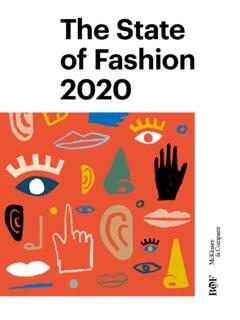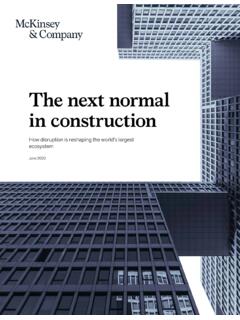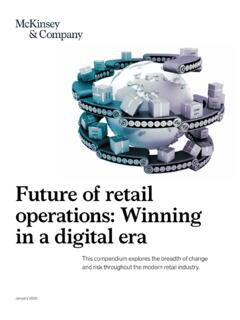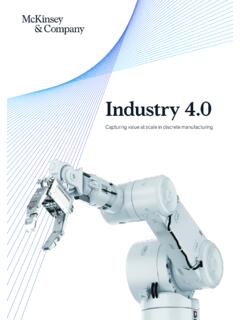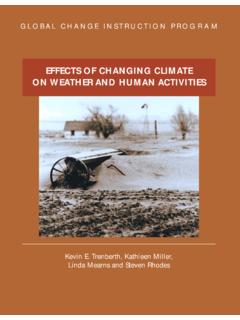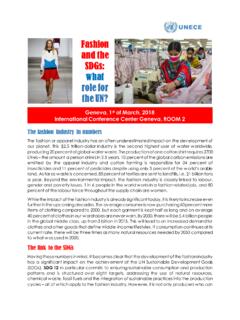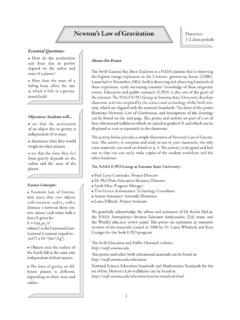Transcription of The State of Fashion 2021 - McKinsey & Company
1 3 The State of Fashion 2021 The State of Fashion 20217 CONTENTSE xecutive Summary 8 9 Industry Outlook 10 13 GLOBAL ECONOMY 16 3301: Living with the Virus 17 Jumia: Balancing Speed with Discipline in a Crisis 2002: Diminished Demand 23 Covid-19 and the New Era of Luxury 29 CONSUMER SHIFTS 34 5703: Digital Sprint 35 Kering: Fast-Tracking a Digital Upgrade 38 Alibaba: Innovating for China s Advanced Ecosystem 4104: Seeking Justice 45 Louis Vuitton: Hardwiring Accountability in a State of Flux 4805: Travel Interrupted 52 Selfridges Group: Managing the Pivot to Local Shopping 55 Fashion SYSTEM 58 9906: Less is More 59A More Circular Fashion Industry Will Require a Collective Effort 6307: Opportunistic Investment 6708: Deeper Partnerships 70 Shahi Exports: Reforming the Fashion Supply Chain 74 Risk, Resilience and Rebalancing in the Apparel Value Chain 7709.
2 Retail ROI 81H&M Group: Making Retail More Resilient 85 Mapping the Retail Portfolio of the Future 8910: Work Revolution 96 THE State OF BEAUTY 2021 100 107 McKinsey GLOBAL Fashion INDEX 108 115 Glossary 116 End Notes and Infographics 118 BEAUTY 2021 MGFIGLOBAL ECONOMYCONSUMER SHIFTSFASHION SYSTEM8 The State of Fashion 2021 CONTRIBUTORSACHIM BERGB ased in Frankfurt, Achim Berg leads McKinsey s Global Apparel, Fashion & Luxury group and is active in all relevant sectors including clothing, textiles, footwear, athletic wear, beauty, accessories and retailers spanning from the value end to luxury.
3 As a global Fashion industry and retail expert, he supports clients on a broad range of strategic and top management topics, as well as on operations and sourcing- related AMEDAs founder, editor-in-chief and chief executive of The Business of Fashion , Imran Amed is one of the Fashion industry s leading writers, thinkers and commentators. Fascinated by the industry s potent blend of creativity and business, he began BoF as a blog in 2007, which has since grown into the pre-eminent global Fashion industry resource serving a five-million-strong community from over 200 countries and territories. Previously, he was a consultant at McKinsey in HEDRICHAs global senior expert in McKinsey s Apparel, Fashion & Luxury group, Saskia Hedrich works with Fashion companies around the world on strateg y, sourcing optimisation, merchandis-ing transformation, and sustainability topics all topics she is also publishing about regularly.
4 Additionally, she is involved in developing strategies for national garment industries across A frica, Asia and Latin R LKENSF elix R lkens is part of the leadership of McKinsey s Apparel, Fashion & Luxury group and works with apparel, sportswear and pure play Fashion e-commerce companies in Europe and North America, on a wide range of topics including strateg y, operating model and merchandising transformations. ANITA BALCHANDANIA nita Balchandani is a Partner in McKinsey s London office, and leads the Apparel, Fashion & Luxury group in EMEA. Her expertise extends across Fashion , health and beauty, specialty retail and e-commerce. She focuses on supporting clients in developing their strategic responses to the disruptions shaping the retail industry and in delivering customer and brand-led grow th YOUNGAs global markets editor of The Business of Fashion , Robb Young oversees content from Asia-Pacific, the Middle East, Latin America, Africa, the CIS and Eastern Europe.
5 He is an expert on emerging and frontier markets, whose career as a Fashion editor, business journalist, author and strategic consultant has seen him lead industry projects around the EKEL F JENSEN Jakob Ekel f Jensen is a consultant in McKinsey s London office, specialising in Apparel, Fashion & Luxury. He works with Fashion and luxury companies as well as investors in the industry across Europe, on topics such as e-commerce, strateg y, value creation, operating model and M&A. ALTHEA PENGA lthea Peng is a Partner in McKinsey s San Francisco office, and leads the Apparel, Fashion & Luxury group for the Americas. In this dynamic industry, she partners with global apparel and retail companies to drive large-scale transformations for profitability and to build new capabilities for grow authors would like to thank all members of The Business of Fashion and the McKinsey community for their contribution to the research and participation in the BoF- McKinsey State of Fashion Survey, and the many industry experts who generously shared their perspectives during interviews.
6 In particular, we would like to thank: Adam Freede, Albert Chan, Alexander Pavlov, Anant A huja, Anne Line Hansen, Anne Pitcher, Charlotte Elstob, Dickson Szeto, Doug Stephens, Elsa Berry, Gr gory Boutt , Helena Helmersson, Josh Gardner, Juan Carlos Escribano, Juliet Anammah, Michael Burke, Mike Hu, Nelli Kim, Philip Guarino, Rania Masri, Robert Burke, Sharifa Murdock and Thiago Alonso de wider BoF team has also played an instrumental role in creating this report in particular Amanda Dargan, Anna Rawling, Anouk Vlahovic, Casey Hall, Chelsea Carpenter, Hannah Crump, Kate Vartan, Lauren Sherman, Niamh Coombes, Nick Blunden, Rachel Deeley, Sarah Brown, Sarah Kent, Tamison O Connor, Venetia van Hoorn Alkema, Victoria Berezhna, Vikram Alexei Kansara and Zoe Suen. The authors would in particular like to thank Sonja Penttil and Sarah Andr from McKinsey s Helsinki and London offices respectively for their critical roles in delivering this report.
7 We also acknowledge the following McKinsey colleagues for their special contributions to the report creation and in-depth articles: Adhiraj Chand, Aimee Kim, Alex Sukharevsky, Andres Avila, Anita Liao, Antonio Gonzalo, Cherry Chen, Claire Gu, Clarisse Magnin, Colin Henry, Colleen Baum, Daniel Zipser, Danielle Bozarth, Ellie Baker, Emanuele Pedrotti, Emily Gerstell, Ekaterina Abramicheva, Ewa Sikora, Fernanda Hoefel, Franck Laizet, Gillian Wright, Hanna Grabenhofer, Hannah Yankelevich, Jihye Lee, John Hooks, Julia Dagef rde, Karl-Hendrik Magnus, Karthikeyan Swaminathan, Libbi Lee, Lisa Renaud, Marie Strawczynski, Mekala Krishnan, Miriam Lobis, Nakul Verma, Neha Onteeru, Nicola Montenegri, Patricio Ibanez, Peter Stumpner, Raphael Buck, Rebeca Vega, Rebecca Zhang, Ryan Shultz, Sajal Kohli, Sakina Mehenni, Sophie Marchessou, Susan Lund, Thomas Tochtermann, Tom Skiles, Ulric Jerome, Valerie Van der Voort, Vorah Shin.
8 We d also like to thank David Wigan and Jonathan Turton for their editorial support, and Adriana Clemens for external relations and communications. In addition, the authors would like to thank Joanna Zawadzka and Lucinda Scholey for their creative input and direction into this State of Fashion report, Martin Nicolausson for the cover illustration and Getty Images for supplying imagery to bring the findings to life. 10 The State of Fashion 2021In Search of Promise in Perilous TimesEXECUTIVE SUMMARYFor the Fashion industry, 2020 was the year in which everything changed. As the coronavirus pandemic sent shockwaves around the world, the industry suffered its worst year on record with almost three quarters of listed companies losing money. Consumer behaviour shifted, supply chains were disrupted and the year approached its end with many regions in the grip of a second wave of infections.
9 A turbulent and worrying year has left us all looking for silver linings both in life and in business knowing full well that we will need to make the most of them in the year , according to McKinsey Global Fashion Index analysis, Fashion companies will post approximately a 90 percent decline in economic profit in 2020, after a 4 percent rise in 2019. Given the ongoing uncertainty, our predictions for industry performance next year are focused on two scenarios. The first, more optimistic Earlier Recovery scenario envisages that global Fashion sales will decline by between 0 and 5 percent in 2021 compared to 2019. This would be predicated on successful virus containment in multiple geographies and a relatively rapid transition to economic recovery. In this scenario, the industry would return to 2019 levels of activity by the third quarter of 2022.
10 Our second, Later Recovery scenario would see sales growth decline by 10 to 15 percent over the coming year compared with 2019. In this case, the virus would continue to wreak havoc despite widespread containment measures and Fashion sales would only revert to 2019 levels in the fourth quarter of either scenario, we expect tough trading conditions to persist next year, in some geographies at least, and for high levels of bankruptcies, store closures and job cuts to continue. At the same time, the pandemic will accelerate trends that were in motion prior to the crisis, as shopping shifts to digital and consumers continue to champion fairness and social the extreme jeopardy facing the industry, there is no simple, standardised playbook for the coming year. Instead, Fashion companies must tailor their strategies to fit their individual priorities, market exposure and capabilities.



